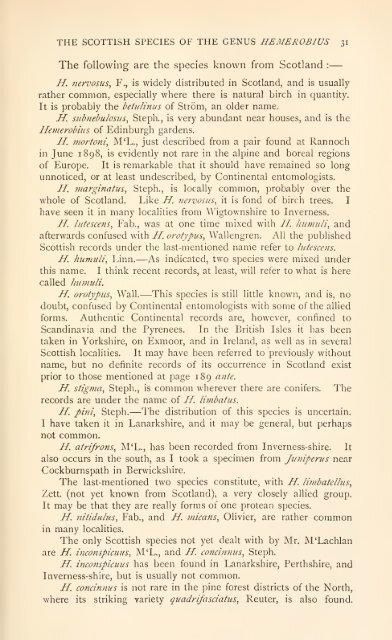You also want an ePaper? Increase the reach of your titles
YUMPU automatically turns print PDFs into web optimized ePapers that Google loves.
THE SCOTTISH SPECIES OF THE GENUS HEMEROBIUS 31<br />
The following are the species known from <strong>Scotland</strong> :<br />
H. nervosus, F., is<br />
widely distributed in <strong>Scotland</strong>, and is usually<br />
rather common, especially where there is natural birch in quantity.<br />
It is<br />
probably the betulinus of Strom, an older name.<br />
H. subnebulosus, Steph., is very abundant near houses, and is the<br />
Hemerobius of Edinburgh gardens.<br />
H. mortoni, M'L., just described from a pair found at Rannoch<br />
in June 1898, is evidently not rare in the alpine and boreal regions<br />
of Europe. It is remarkable that it should have remained so long<br />
unnoticed, or at least undescribed, by Continental entomologists.<br />
H. marginatus, Steph., is locally common, probably over the<br />
whole of <strong>Scotland</strong>. Like H. nervosus, it is fond of birch trees. I<br />
have seen it in many localities from Wigtownshire to Inverness.<br />
H. liitescens, Fab., was at one time mixed with If. humuli, and<br />
afterwards confused with H. orotypus, Wallengren. All the published<br />
Scottish records under the last-mentioned name refer to lutescens.<br />
H. humuli, Linn. As indicated, two species were mixed under<br />
this name. I think recent records, at least, will refer to what is here<br />
called humuli.<br />
H. orotypus, Wall. This species is still little known, and is, no<br />
doubt, confused by Continental entomologists with some of the allied<br />
forms. Authentic Continental records are, however, confined to<br />
Scandinavia and the Pyrenees. In the British Isles it has been<br />
taken in Yorkshire, on Exmoor, and in Ireland, as well as in several<br />
Scottish localities. It<br />
may have been referred to previously without<br />
name, but no definite records of its occurrence in <strong>Scotland</strong> exist<br />
prior to those mentioned at page 189 ante.<br />
If. stigma, is Steph., common wherever there are conifers. The<br />
records are under the name of H. limbatus.<br />
H. pini, Steph. The distribution of this species is uncertain.<br />
I have taken it in Lanarkshire, and it<br />
may be general, but perhaps<br />
not common.<br />
H. atrifrons, M'L., has been recorded from Inverness-shire. It<br />
also occurs in the south, as I took a specimen from Juniperus near<br />
Cockburnspath in Berwickshire.<br />
The last-mentioned two species constitute, with H. limbatellus,<br />
Zett. (not yet known from <strong>Scotland</strong>), a very closely allied group.<br />
It<br />
may be that they are really forms of one protean species.<br />
H. nitidulus, Fab., and H. micans, Olivier, are rather common<br />
in many localities.<br />
The only Scottish species not yet dealt with by Mr. M'Lachlan<br />
are H. inconspicuus, M'L., and H. concinnus, Steph.<br />
H. inconspicuus has been found in Lanarkshire, Perthshire, and<br />
Inverness-shire, but is usually not common.<br />
H. concinnus is not rare in the pine forest districts of the North,<br />
where its striking variety quadrifasciatus, Reuter, is also found.

















